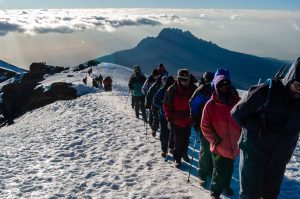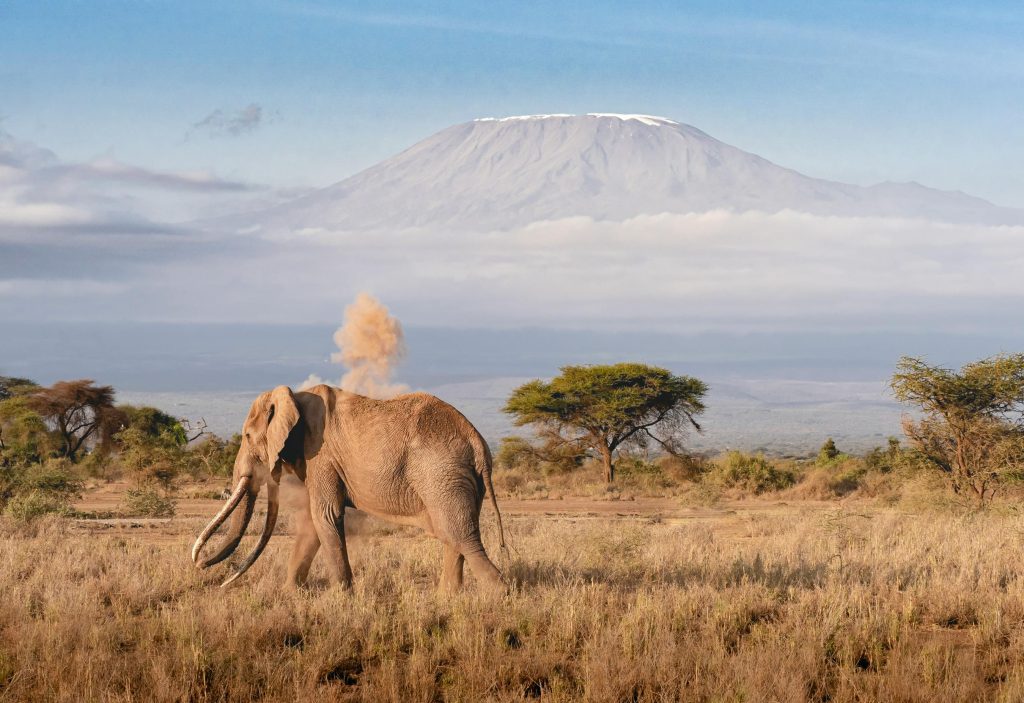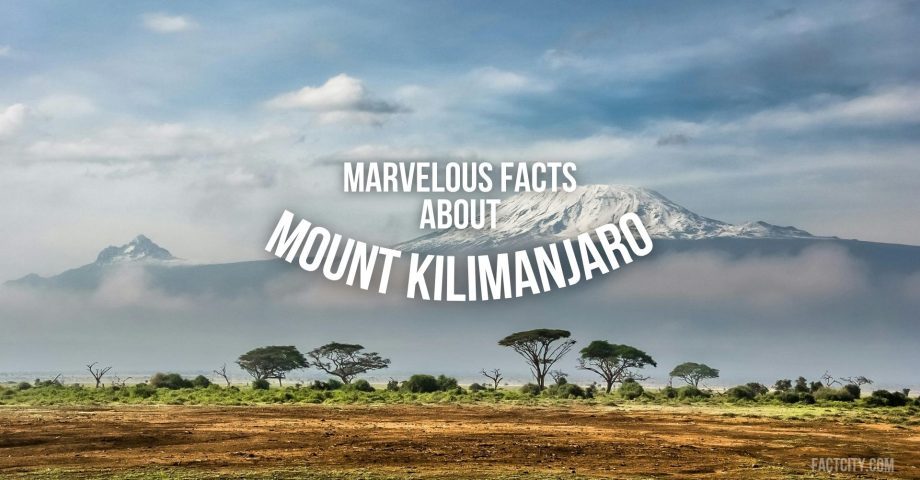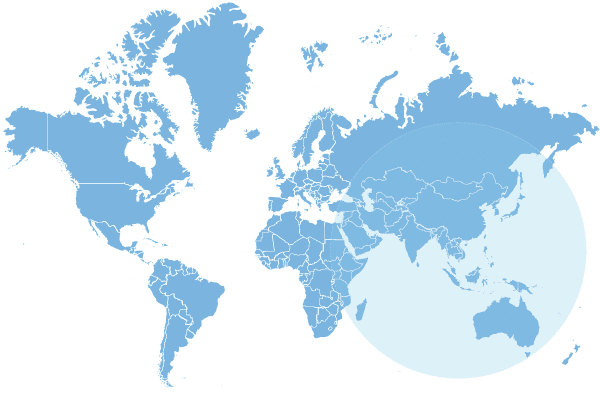Kilimanjaro is one of the world’s most fascinating peaks! A UNESCO heritage site, this African volcano is a massive tourist attraction. In fact, many people try to climb it for its amazing views! That said, it’s thought only half the people who try actually succeed – so, be sure to train and not to bite off too much you can chew.
Naturally, given that it’s such a huge deal (quite literally), I’ve put together some fascinating facts about Mount Kilimanjaro to help inspire your next pub quiz. Take a look through and see what you can learn!
1. Kilimanjaro isn’t a mountain – it’s technically a volcano.
Mount Kilimanjaro is located in Tanzania, Africa. It is a snow-capped volcanic mountain composed of rock and ash and lava, so-referred to as a ‘stratovolcano’.
In fact, it’s actually made up of three different stratovolcanic cones. These are Mawenzi, Kibo, and Shira. It’s a free-standing volcano, too, because it is not attached to a mountain range. The tallest of the cones is Kibo at the summit.
2. There’s a chance it might erupt.
Indications show currently Kilimanjaro is inactive and therefore regarded as officially dormant. It is monitored constantly! Some evidence indicates that the last activity was at Kibo, one of the three summits, approximately 10,000 years ago. Hopefully, it’s not overdue to blow a gasket!
That said, dormant volcanoes can still surprise us. Mount Etna, for example, is a volcano that erupted in June 2025, uprooting many who had been used to its relative quiet! Chances are, Kibo won’t erupt any time soon, but you can never say never.
Luckily, experts say there’s very, very little chance that either Shira or Mawenzi will erupt again – they’re considered long extinct.
3. Kilimanjaro is extremely old.
Kilimanjaro is believed to be approximately four million years old. However, compare that to Glen Coe, in Scotland! This breathtaking Scottish sight was once home to a supervolcano that’s said to have erupted more than 400 million years ago!
4. There’s a box at the top of Kilimanjaro.
A curious wooden box at the top of Kibo contains a book. This is for climbers arriving at the summit to write about how they feel on achieving their goal and to read the thoughts of predecessors! Think of it as like the world’s most adventurous guestbook!
5. People of all ages have climbed to the summit.
Several octogenarians have reached the summit of Kilimanjaro. Both Valtee Daniel and Fred Distelhorst were in their late 80s when they climbed to the top of the volcano! However, Anne Lorimor, aged 89 at the time of climbing, claimed the record for the oldest person to scale the heights of Kilimanjaro in 2019.
What’s more, Bernard ‘Bern’ Goosen is a record-holder all on his own. He was the first person ever to climb Kilimanjaro in a wheelchair! Despite being a quadriplegic, Goosen has scaled the peak twice!
6. Kilimanjaro’s ecosystems are incredible.
Due to its height above sea level, several regions of ecosystem exist across the cones of Kilimanjaro. They include the Arctic summit, an Alpine desert, rainforests, moorland, cultivated zones and heathland. These support a plethora of flora and fauna – as you might expect!
Officially, Mount Kilimanjaro is around 19,341 feet, or 5,895 metres, above sea level. That actually makes it the tallest mountain in Africa, and even makes it the tallest free-standing volcano on the planet.

7. The area is home to more people than you might think.
The Kilimanjaro region is one of many administrative areas within Tanzania, and as such, it does also have a human population! In fact, a census carried out in 2012 showed that there were around 1.8 million people living around Kilimanjaro. For perspective, that’s around three times the number of people who live in Leeds.
8. Many people have studied the wild weather at the summit.
A Kilimanjaro weather station was installed by the University of Massachusetts in February 2000. Its main purpose is to monitor glaciers at the summit. Unfortunately, due to global warming, the glaciers that once capped the volcano have declined hugely, with there now being smatterings of icy patches as opposed to a blanket.
In fact, scientists have raised concerns that within 20 years, Kilimanjaro’s summit may be devoid of snow. Since 1912, records illustrate that 80% of the snow has vanished.
In terms of weather up here generally, you’ll want to plan ahead if you intend to climb. The climate around Mount Kilimanjaro can really vary – on average, you’re likely to expect temperatures of around 27 °C at the base, and at the very summit, you could experience temperatures of anywhere between -20 and 20 °C! It’s always worth checking the weather forecast before you go, but generally, climbing during the dry seasons (after May) is best.
9. It makes for a challenging climb and trek!
Annually, approximately 50,000 people attempt to reach the summit – and over one-third fail due to altitude-related issues. It takes a strong set of lungs to reach these peaks.
That said, Kilimanjaro has something of an unfair reputation when it comes to being a deathly climb. Yes – it is immensely tall and certainly not a trek for beginners – but people rarely die when climbing it. It’s estimated up to ten people die from climbing Kilimanjaro every year – which, admittedly, is more than enough – but that’s barely a 0.02% mortality rate.
You can avoid getting injured or suffering a worse fate up here by making sure to pack adequate climbing equipment and to train and follow proper techniques. It’s also a good idea to try and climb with a tour guide, regardless of your mountaineering experience!
10. Dehydration can seriously set you back on a Kilimanjaro climb.
Not to keep on a morbid note, but another way you can keep safe when climbing any mountain is just to make sure you have enough water in your system!
It has been proven, despite warnings, many people fail to have a successful climb due to dehydration. At such altitude during exercise, the human body needs 4.5 to 5 litres of water per day. Additionally, climbers are advised to add electrolytes to their drinking water.

11. Kilimanjaro is one of the Seven Summits.
Remember how I mentioned that Kilimanjaro is the tallest mountain of its kind in Africa? That puts it in an impressive club with six other peaks, each of them being the tallest on each of the other continents.
That means it’s rubbing tall shoulders with the likes of Mount Everest in Asia, Mount Aconcagua in South America, Denali in North America, Mount Elbrus in Europe, and Mount Vinson in Antarctica. Many people also include Mount Kosciuszko, in Australasia.
Out of this group, Kilimanjaro sits in the middle. It’s taller than Mount Elbrus, but shorter than Denali. It also dwarfs the UK’s tallest mountain, Ben Nevis, which is around 4,413 feet, or 1,345 metres tall. Ben Nevis is taller than Mount Kosciuszko, but just shorter than Mount Vinson.
12. Sheila MacDonald was the first woman to climb to the top.
Sheila MacDonald, from Scotland, set the ball rolling for female mountaineers everywhere as reportedly the first woman to reach the top of Kilimanjaro back in the 1920s. It’s thought that she’d already built up some talent for climbing having explored the peaks of her homeland – and would eventually scale Kilimanjaro in 1927, drinking whisky to keep her nerve up!
13. Someone once climbed Kilimanjaro in a rhino costume.
That person, believe it or not, was Douglas Adams, author of the Hitch-Hiker’s Guide to The Galaxy and Dirk Gently novels! Adams climbed to the summit in a rhino outfit along with the leaders of the Save the Rhino Foundation.
It was, of course, a charitable effort in an attempt to raise awareness of rhino hunting and extinction threats across Africa. He undertook the weird walk in 1994.
14. Thousands of British people climb Kilimanjaro every year.
Approximately 5,000 Brits or more attempt to scale the volcano each year, which, for a time, put the UK in second place on the tourist leaderboard (behind the US, and ahead of Germany). It’s safe to say we’re a nation of adventurers and risk-takers!
Of course, ‘homegrown’ climbs such as Snowdon, Ben Nevis, Scafell Pike, and Ben Lomond remain more popular with UK mountain climbers – but the fact around 10% of Kilimanjaro’s yearly climbers are British is a fantastic stat!
15. It’s relatively easy to travel to Kilimanjaro from the UK.
Naturally, the best way to visit the volcano is to find a flight between the UK and Tanzania. Airlines across the country will take you directly to Kilimanjaro, or you can even stop in glorious Zanzibar, or go explore Dar Es Salaam or Arusha.
The most popular routes out towards Kilimanjaro International Airport start from Luton, Manchester, London Stansted, London Heathrow, and London Gatwick. Always check the latest prices and flight directories before making any hard and fast decisions – resources online such as SkyScanner and Rome2Rio are great starting points.

16. The UK government offers some travel advice when it comes to visiting Kilimanjaro.
At the time of writing, the British government recommends that you avoid all but essential travel if you intend to head within 20 km of the Cabo Delgado Province border with Tanzania. It’s here where the Tanzania-Mozambique border has suffered extremism and terrorism in the past.
Therefore, it’s best to stick to travelling to Kilimanjaro directly if you can, but remember that all travel will have risks. It’s best to travel in groups, for example, for security.
To enter Tanzania from the UK, you’ll need to make sure that your valid passport has at least six months left on it after you intend to arrive – and, you’ll need a blank page for stamps. Tanzanian border control will also require you to have a visa, and to submit to mpox screening. It’s also wise to have a yellow fever vaccination, and to avoid bringing or removing any wildlife items.
17. Always make sure to exchange your money before travelling.
If you’re heading on holiday to Tanzania and Mount Kilimanjaro, you’ll need to make sure you have Tanzanian Shilling, or TZS, available. At the time of writing, the exchange on one British Pound is around 3,600 TZS.
This has been on a steady climb for some time. Therefore, always make sure to check the latest exchange rates before you travel – different global and political events can change how much money you receive in TZS.
18. If you need help while travelling, you’ll need to contact the British High Commission Dar es Salaam.
If you’re travelling to Kilimanjaro from the UK, it’s always wise to have access to local help in case you need travel documents or run into an emergency. In which case, you should always contact the British High Commission Dar es Salaam in Tanzania.
The full address for the commission is British Commission Dar es Salaam, Umoja House, Hamburg Avenue, PO Box 9200, Dar es Salaam, Tanzania. You’ll need to make an appointment with the commission first if you want to access its services.
GOV.UK has further information here on who and how to contact the service if you need help in an emergency while you are in the area.
19. There are tons of wonderful flora and fauna around the area.
As mentioned, the fantastic landscapes surrounding Kilimanjaro means there’s some truly wonderful wildlife that you might be able to spot when travelling around the region. That said, it’s uncommon that you’ll see many larger animals, though you can sometimes spot elephants and buffalo.
Around the mountain, you are more likely to see the likes of shrews and chameleons. That said, eagle-eyed travellers have also been able to spot zebras, mongooses, leopards, bushbucks, hyenas, and more!
Thankfully, Mount Kilimanjaro itself has been a conservation spot for some time, since the early 1970s. That means that it’s greatly protected against any human activities that are likely to upset its amazing ecosystems. What’s more, it’s also banned for trees in the area to be harvested, meaning that the area’s biodiversity will be protected for many years to come.
20. It sits very close to the equator.
Believe it or not, despite the fact that the temperatures on and around the volcano vary wildly, and that it has developed glaciers in the past, Mount Kilimanjaro is actually very close indeed to the equator! It’s around 205 miles away, which stupified visitors who first saw the ice caps – which gives weight to theories that glaciers can come and go during ice ages.
21. No one’s really sure where the name came from.
There are varying accounts regarding what ‘Kilimanjaro’ actually means, and where the name actually came from in the first place. Some believe that it was adopted by the original visitors to the range who came from Europe – and that it was derived from Swahili.
However, there’s also claims that it’s a combination word meaning ‘white mountain’, from the Swahili ‘Kilima’ (mountain) and Chagga ‘Njaro’ (whiteness). Then, there are even more claims that the name actually translates to ‘great mountain’ or ‘snow mountain’.
Perhaps most entertainingly, many believe that it’s a simple mispronunciation of a KiChagga phrase which roughly translates into ‘we failed to climb it’! Given that only around half of the people who attempt to climb Kilimanjaro actually succeed, it’s a pretty apt descriptor!
Regardless – it’s a great name, but its origins are pretty mysterious!

FAQs About Kilimanjaro
How big is the Kilimanjaro National Park?
The Kilimanjaro National Park covers an area of 652 square miles, or 1,688 square kilometres. It was established as a Nature Reserve in 1921 and a National Park in 1973 in order to protect the forest environment and inhabitants. It’s also been listed as a world heritage site by UNESCO – fittingly enough!
How high above sea level is Mount Kilimanjaro?
It reaches a height of 5,895 feet above sea level from a 4,900-foot plateau. That’s a lot of volcano to start climbing! It’s the world’s biggest free-standing mountain, too, making it a massive challenge for even the most seasoned climbers. Take a deep breath and see how you go!
Can a beginner climb Mount Kilimanjaro?
Yes! However, due to risk of altitude sickness and dehydration, you’ll need to do quite a bit of preparation beforehand. Try and train before you go and you might just make the peak! It’s also a good idea to try and climb with a group, or to at least have a seasoned tour guide or climbing leader who can safely help you to the summit.
Further reading
https://facts.uk/tag/mountains
https://www.climbing-kilimanjaro.com/
https://www.muchbetteradventures.com/magazine/the-beginners-guide-to-climbing-mount-kilimanjaro/
Do you know any fun facts about Kilimanjaro? Share them in the comments below!










